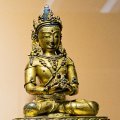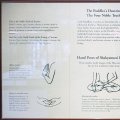Patan Museum (Nepal): photo 110
Photo 110 of 212 in Gallery: Patan Museum (Nepal)

Image title: The Three ways of Buddhism
Description of the photo
The Three Ways of Buddhism
Today within Buddhism there are three “Ways” (yana) to salvation. The oldest is the conservative Way of the Elders, or Disciples (Theravada, Shravakavana). It adheres most closely to the tenets of the Historical Buddha which focus on individual salvation through self-imposed mental and physical discipline as a celibate monk or nun. It was later referred to as Hinayana, the “Little Way,” a pejorative term best forgotten.
Around the turn of the common era a new Way, the Great Way (Mahayana) evolved which encourages the individual to seek the liberation of all beings. To do so, the concept of the Bodhisattva was expanded. Bodhisattvas now became compassionate beings, human or divine, who postpone their own salvation to help others attain it. Mahayana also posits the existence of many Buddhas, past and future, each an aspect of one Ultimate, transcendent Buddha. Among them are the Five Buddhas who dwell in paradises where through the help of Bodhisattvas the faithful can aspire to join them.
At least by the seventh century of the common era-and probably far earlier—the Tantric ideas then pervading Hinduism affected Buddhism and. a third Way evolved. It is known as the Way of the Diamond or Thunderbolt (Vajrayana), Way of the Tantras (Tantrayana), or simply Tantric Buddhism. It is a specialized, esoteric path within the Great Way which offers a shortcut to redemption. Techniques involve meditation, elaborate psycho-sexual rituals, magic formulas (mantras), mystic diagrams (mandalas), and various “left hand” practices such as ritual consumption of otherwise forbidden substances such as meat and alcohol. Vajrayana can only be learned from a Tantric master whose skills are ultimately based on Buddhist Tantras, esoteric texts that parallel Hindu Tantras.
In Nepal all three Ways are followed but influence one another in belief and practice. Theravada, the Way of the Elders, is still the Buddhism of Sri Lanka and much of Southeast Asia while Mahayana is preferred in China, Korea, Japan, and Vietnam. Tibet is Mahayanist interwoven with Vajrayana.
Buddhism in Nepal and Tibet
In Nepal Buddhism is practiced by large numbers of Newars—the traditional inhabitants of the Kathmandu Valley-by various ethnic groups outside of it such as the Sherpa and Tamang, and by Tibetan refugees. Together they are a minority among Hindus with whom they share many socio-religious aspects. In the Kathmandu Valley and Tibet, where most of the Objects displayed in this gallery were made, the dominant Ways of Buddhism are the Great Way and the Diamond Way (Mahayana and Vajrayana). Theravada also has an increasingly important independent following in the Kathmandu Valley.
In contrast with Tibet, Buddhism as practiced in the Kathmandu Valley—Theravada excepted—has no institution of permanent celibacy nor monastic residence. Rather, there is a laity and a caste of part-time “monk-priests” consisting of Vajracharyas (“Masters of the Thunderbolt”) and Shakyas. All males of these castes are hereditary members of institutions, culturally defined as monasteries (bahah, bahi or in Sanskrit, vihara), into which they are initiated by special rites and with which they have social and ritual obligations. There are some 150 Buddhist monasteries in Patan alone and an almost equal number in Kathmandu. Bhaktapur [Bhaktapura] has scarcely any.
In the caste hierarchy, Vajracharyas essentially command the same position as the Brahmans of Hinduism. They are Vajrayanist. They hold occasional office in their monastery and optionally, may serve as domestic priests. In effect they are mortal Bodhisattvas (in helping others attain nirvana) and Siddhas, Tantric saint practitioners who command the methods of attaining enlightenment here and now. Only Vajracharyas may minister to the esoteric deities.
For lay Nepalese Buddhists, at least, the theoretic aspiration of non-being in nirvana is superseded by the concept of “crossing over,” that is to reach the Sukhavati paradise of Buddha Amitabha.
Gallery information:
The Patan Museum is located on the Durbar square of Patan (Lalitpur/Lalitapura, Kathmandu, Nepal) which is associated Keshav Narayan Chowk (Keshavnarayan)—a form of Lord Vishnu. Being listed as a World Heritage Site, the whole of Durbar square is filled with exquisite temples, sculptures and other ancient structures, of which the ancient history history can be traced to the Malla Kings of Lalitpur. It is an important site for both Buddhism and Hinduism.
Photo details:
Date: 2019-12-02
Camera: SONY ILCE-6400
Exposure: 1/160
Aperture: f/4
ISO: 1600
Focal length: 18mm
High resolution:
Download file
Size: 4.04 MB
Resolution: 3463 x 2000
© Photograph by Gabe Hiemstra.
License: CC BY-NC-ND 4.0

